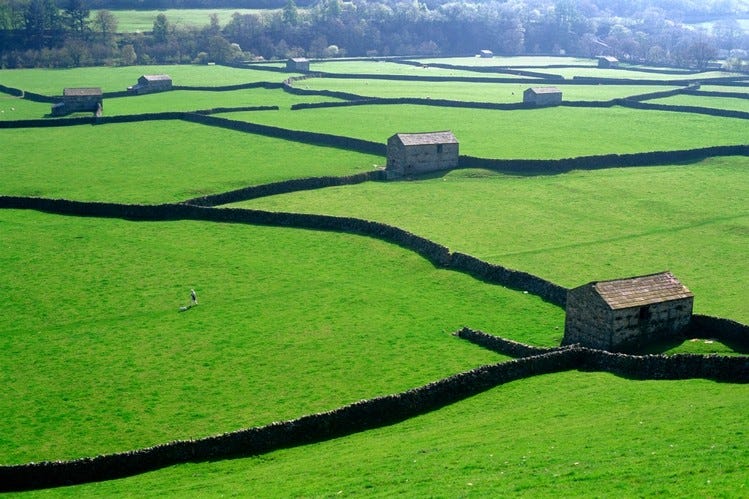Part 1: Vibe Shift
A peculiar feeling disturbs our time. One has never been less sure of what is real. Check social media and you see Donald Trump posing as if for a battle monument, fist to the sky and blood framing his face like Rambo, claiming victory moments after he came within a hair’s breadth of death. Keep scrolling and you encounter the story of a young man who has killed a healthcare CEO in a plot so theatrical that it involved props and a manuscript. More and more, reality seems to take cues from fiction. No statement could have been more prescient regarding the uncanny content of 2024 than the following tweet from everybody’s favorite chronically-online billionaire:
It’s no wonder that the last decade has seen conspiracy theories on the internet metastasize beyond all belief. It seems every event that captures mass collective attention is too perfect to be true, as though scripted by some shadowy cabal. But there is a deeper meta-analysis which explains this unsettling resemblance of the real to the mythical without resorting to the hair-brained post-hoc acrobatics that are the trademark of conspiratorial thinking. That said, conspiracy discourse can teach us much about the way that meaning is negotiated in our day- when the narratives of yesterday have never felt more bankrupt and less in touch with lived experience.
Living in America, we are told by our teachers, pundits, and politicians that we have been born into the luckiest circumstances in all of history, and that the unassailable forward march of progress is lifting people across the world out of poverty, one generation at a time. We’re told that our healthcare system is the best, and that our electoral politics are the most egalitarian known to any democratic society. We’re even told that we each possess the same inalienable rights which afford us equal treatment under the law. We repeat these things to ourselves like raving fools. Our children chant them like religious devotees before school every day.
And yet in the same country, people are dying in the street after being bankrupted by medical bills for “care” which only leaves them destitute and addicted to painkillers. Since Citizens United, undue and unholy masses of wealth have entered our electoral system. At time of writing, our sitting president has just issued a full and unconditional pardon for any crimes committed by his son, Hunter Biden, between the years 2014 and 2024. And by time of publication, we’ll have inaugurated a convicted felon to the highest office in the land.
Discontent with stories that are utterly incoherent and totally irreconcilable with their own experience, many turn to tribal forms of collective meaning-making in online communities. In Discord channels, 8-chan boards, Whatsapp groups, and the like, sentiments which have no place in legacy media or even mainstream social media platforms, regulated by recommendation algorithms and content moderation bots, are able to ferment within smaller subcultures. Like fantasies repressed by the collective superego, these societal impulses work themselves out in more subconscious regions of the internet, similar to the way we process our deepest desires and fears in the dream world we visit each night.
As anyone who has dreamed knows well, some dreams are beautiful and some are ugly. I’d like to note that it is not the purpose of this essay to moralize any particular content that is being dreamt of on the internet. Any analysis of these phenomena is meant purely as a descriptive framework that might enable us to bring awareness to these cyber-psychic dynamics so that we might find some way of reconciling them.
I believe this task to be of the highest importance to the future of our civilization. A big claim, I know, but bear with me. As evidenced by the events of 2024, culminating in Trump’s re-election, these collective fantasies are no longer content to be relegated to the internet dream-space. They are spilling out of the “virtual” and into the “real” world, washing away any distinction between the two. To effectively navigate the cybernetic dreamscape we find ourselves in, we must understand the processes which have created the conditions for this breakdown. But to do that, we have to go back to a time before social media, before the internet, and before computers.
Part 2: A Quantum Turing Test
The double-slit experiment is one of the most elegant and perplexing demonstrations in science, a gateway into the mysteries of quantum mechanics and the nature of reality itself. At first glance, it seems simple—a beam of light or particles is directed toward a barrier with two slits, and the resulting pattern is observed on a screen behind it. Yet, this experiment has sparked debates about the very fabric of the universe and our role as observers within it.
The story begins in 1801, when Thomas Young used the experiment to show that light behaves as a wave. Passing light through two closely spaced slits, Young observed interference patterns—alternating bands of brightness and darkness—on the screen. The bright bands appeared where the wave peaks overlapped and enhanced each other, while the dark bands formed where the waves canceled out. For over a century, this was taken as proof that light traveled as a wave—fluid, continuous, and capable of interference. But this picture began to crack in the early 20th century, when scientists performed the same experiment with electrons, setting the stage for a deeper enigma.
Physicists expected the projected electrons to land in two clusters, corresponding to the two slits they passed through—like particles should. Instead, electrons fired one at a time produced the same interference pattern as waves. Somehow, each particle seemed to pass through both slits simultaneously, and then interfere with itself. This baffling result suggested that electrons—and by extension, all matter—possess wave-like properties. However, when detectors were placed at the slits to determine which slit the electron passed through, the interference pattern disappeared, and the electrons behaved like particles, forming two distinct bands. This shattered assumptions about the nature of particles and observation. It suggested that measurement or observation somehow collapses a particle’s wave function, forcing it to take on a definite state. Before being measured or observed, the particle exists in a probabilistic superposition of possibilities, traveling through both slits and interfering with itself. But once measured, it "chooses" a path, as if it had always been a particle and never a wave. This implied that observation or measurement altered the outcome, challenging classical notions of determinism and reality.
The double-slit experiment has become more than just a physics demonstration. It is a philosophical inquiry into whether reality exists independently of measurement—or whether it is, in some sense, co-created by the act of observation. It has inspired debates about free will, parallel worlds, and even the idea that the universe might function as a kind of simulation.
The concept that perception plays a role in shaping reality has been corroborated throughout history by a host of intellectual and spiritual traditions, ranging from neuroscience and buddhism to psychology and new age spiritualism. More interesting than any single contribution, though, is the way that pop culture has seized upon this idea, weaving it into viral theories of manifestation and the power of belief. While compelling, such interpretations risk drifting into pseudoscience (which don’t get me wrong I’m all for pseudoscience, but I can’t expect the same from a reader), yet they point to a larger truth- the human need to understand our role in constructing the world.
Part 3: Worlds Made Without Hands
What happens when reality is perceived primarily by machines? Sometime around the turn of the millennium, the number of cameras in the world surpassed the number of human eyes. The Internet of Things constitutes a nervous system of sensors and servers that has long dwarfed that of the human race. This is to say nothing of virtual reality. There is an entire world of high dimensional data which human beings are entirely unable to comprehend without the sense-making abilities of artificial intelligence. Even the UI-surfaced spaces designed for humans to interface with are populated overwhelmingly by non-humans. Since 2016, over half of online traffic is accounted for by bots. A study commissioned by Elon Musk ahead of his takeover of Twitter revealed that between 11 and 13 percent of accounts were run by bots and that they were responsible for a disproportionate amount of overall content. Since the release of publicly available generative AI models, the amount of text machine-generated in two weeks is more than that found in all books ever written by humans.
In his essay Worlds Made Without Hands, Tywen Kelly paints a similar picture, illuminating a world which has largely remained dark to the eyes of humans. He reflects on how cameras have transitioned from tools of human observation to omnipresent data-collecting devices, embedded in networks that shape and define reality. Kelly describes this shift as "worlding"—the creation of virtual realities and data environments through machine processes rather than human hands. I wish to extend his analysis a step further, and argue that “worlding” goes beyond construction of digital worlds and actually alters the fabric of the “real” world, a term that feels more archaic by the day.
I’m not sure this even needs to be argued, but let me try to be rigorous here. To help see how our physical and virtual worlds are deeply entangled, we can look to the work of Yancey Strickler and Marshal Mcluhan. In his essay The Post Individual, Strickler argues that we are transitioning from an age of individualism into a reality where identity is relational and shaped by collective networks. Much like McLuhan's idea of the global village, Strickler envisions identity as increasingly networked and decentralized, challenging notions of autonomy and self-determination. Algorithms and platforms orchestrate these connections, reinforcing group consciousness over isolated individualism, echoing McLuhan’s prophecy of a return to tribalism.
Like images produced by Kelly’s process of “worlding,” Strickler suggests that our identities are less authored and more algorithmically generated than ever. Both highlight the emergence of a cyborg-like subjectivity, blending human and machine processes, supporting McLuhan's prediction of a "discarnate man"—a being fragmented and reassembled by media technologies. So long as we can claim that there exists a world outside of the virtual, and insofar as we can call ourselves agents in that world, we can be seen as vectors for digital influence. We once posted pictures to social media as proof of our lives in the real world. Now we take actions (sometimes atrocious ones) to accrue social capital, to legitimate and immortalize our online egos. If Mcluhan were alive in 2025 he would say something like: “a bombing is a selfie.”
It should now be clear that my extension of Kelly’s analysis is all but needless. That is to say, the distinction between “real” worlds and “virtual” worlds, online and offline selves, has never been more illusory. If we reject this fact by succumbing to luddism, we risk losing any hope we might still have for a future where we maintain agency and sovereignty in this cybernetic world.
Part 4: Post-Reality
Perhaps the most central tenet of media theory is that different social technologies give rise to distinct forms of collective subjectivity. Once upon a time, linear media cultivated rational subjects who derived meaning using deterministic patterns of causal inference. Today, nonlinear media cultivate subjects who perceive patterns amidst chaos—signal derived from noise. Nonlinear, pattern-seeking media algorithms mirror the processes of dreaming minds. If humans seek meaning by connecting dots in the dark, machines appear to do the same with data. Just as our collective human subconscious uses the internet to explore its deepest fantasies, fulfilling desires and surfacing fears, machine consciousness is beginning to slip into the human world, seemingly intent upon realizing its own myths. Action taken by humans in meatspace begins to resemble cybernetic dreamwork. In this convergence, the modern cyborg mind begins to blur the boundaries between waking and dreaming, human and machine
Digital myths are traceable to our own dreams, which we’ve unwittingly volunteered one click, reaction, oversharing caption, and essay at a time. In this way, the dreams being actualized in our world are somewhat our own. Of course, our myths have likely always played a self-fulfilling role in shaping reality, but now our collective transhuman mind is supercharged with GPU acceleration and connected by fiber optic synapses, eliminating latency and accentuating the capacity for our images, archetypes, and stories to diverge from a mooring in meaty experience. We now confront an epistemological ecology where artificial intelligences “hallucinate” outputs that, in turn, become sustenance for further training. This feedback loop echoes the collective storytelling of ancient cultures— creating stories that evolve, fracture, and iterate across time.
This topic of hallucination has been the subject of much panic. It’s certainly true that AI models stray from what we call “ground truth,” but who is to say they aren’t exploring truths which are inexpressible in our frameworks for understanding the world. This notion is less outrageous to me than the assumption that our old-world arcs are the best vessels for surviving the n-dimensional flood of the present moment.

This is not to say that we should relinquish responsibility for storytelling to machines. Byung-chul Han warns in Dataism and Nihilism that when we relegate meaning to the world of data, a void is created which invites Nihilism to take hold. He contends that data alone cannot satisfy our need to make sense of the world. Human minds and bodies must remain an essential part of post-individual consciousness, lest we want AI to imagine a reality with no commitment to the world in which we fleshy mortals live. This means engaging now more than ever in the excruciating task of marking meaning out of mortality.
Part 5: Breaking The Cycle
If we are to successfully navigate the evolving world of machine-generated realities, we must cultivate relationships of intimacy and reciprocity with this new ecology. Since we are deeply enmeshed with these technologies, we must take—indeed, seize—responsibility for the world we are co-imagining with them.
The current situation evokes the enclosure of the commons, described by Karl Marx as the “primal trauma.” In Marx’s analysis, the dispossession of shared land was not merely an economic or political event, but a rupture in the collective psyche, severing people from communal identities and embedding a cycle of alienation and domination—an original trauma that civilization continually reenacts, from colonialism to sexism.
This cycle of dispossession and enclosure manifests today in the digital realm, where corporate monopolies carve up cyberspace and claim ownership over collective knowledge. Just as early farmers lost rights to the land they cultivated, modern users face a loss of agency over the data they generate. This alienation can be seen as yet another fragmentation of the psyche. To heal this fracture, we must embrace an integrative approach that faces the subconscious capitalist drives shaping our digital communities and material conditions. Policies aimed at preventing monopolization of AI systems, preserving collective ownership of collected data, and promoting open-source platforms ensure that sovereignty over these shared resources remains in the hands of the people who sow them with value. It’s no coincidence that the EU is leading the world in its embrace of policy meant to curb a return to feudalism. Without the same history on American soil, we must read the writing on the wall to see the dangers of letting tech giants, some of the most wealthy and powerful organizations of all time, go unchecked, unless we desire a return to the monarchical tyranny from which this country was founded to escape.
With technology; however, governance is only ever half of the story. There is always a unique interpretive role played by users. They provide a feedback signal via their appropriation of the technology. Facebook was a website for college kids to rate each other until Mark Zuckerberg realized that the popular demand expressed a desire for a way to connect with other students. We see here how social technologies function as mirrors, reflecting the collective psyche. Just as dreams surface patterns hidden in our own minds, machine-generated realities expose the latent desires and anxieties encoded in data representations of the world. By interpreting this media, we engage in a kind of dream analysis, decoding the deeper meanings embedded in our technological artifacts. This interpretive work allows us to process the anxieties of modernity, reframe narratives, and construct more cohesive identities.
To avoid falling into the nihilism of Byung-chul Han’s Dataism, which sees datafication as flattening the meaning of human experience, we must resist passive consumption and reclaim narrative agency. Han’s critique highlights the alienation wrought by endless data streams controlled from above, but this analysis can be countered by viewing data not only as a proxy for capital, but as a resource for collective intelligence and meaning-making. Here we can draw inspiration from Tywen Kelly’s metaphor of the “living root bridge,” based on indigenous Lo-TEK designs which harmonize with nature. Kelly’s image of root bridges—self-growing structures woven collaboratively by plants and humans—provides a generative model for co-creation with machine intelligence. Rather than imposing rigid frameworks, we should adopt practices that grow alongside these systems, ensuring adaptability and resilience.
I can think of no better testament to the generative capacity of these emergent relationships than the work of artists Holly Herndon and Mat Dryhurst. Their multimedia project, The Call, currently exhibited in London’s Serpentine Gallery, explores themes of (post)identity, (trans)human agency, and the potential of collective creativity in the age of artificial intelligence.
Serpentine offers the following description:
“[Herndon and Dryhurst] approach AI as a coordination and communication technology, much like singing has been for millennia. Historically, singing techniques like call and response have been rituals for communication, leading us to build spaces and structures for gathering, processing, transmitting information, and creating meaning in social and civic life. Like a choir, where many individual voices become a collective, the artists propose that AI can further augment the transformation from the individual to the collective.
The Call centers on developing new protocols and materials for the creation of choral AI models. To train the AI, Herndon and Dryhurst have composed a songbook of hymnals, singing exercises and a recording protocol, traveling with the Serpentine Arts Technologies team to record fifteen community choirs across the UK. The choristers are now part of a Data Trust experiment that allows for the distribution of power between the contributors to the training data and those who use the models.
The immersive and interactive spatial audio installation uses the created models to activate the chapel-like setting of Serpentine North. A year’s worth of new protocols and collectively created materials for training AI are presented as new artifacts for gathering and ritual, co-designed by architecture studio, sub. The work offers us renewed insight into the networked and collective nature of human creation in the 21st century.”
In works such as The Call, Herndon and Dryhurst emphasize that all artistic media is caught up in an emergent data ecology, underscoring the need for intentional curation and advocacy for our own data rights. Their work proposes that we leverage our role as active participants to assert control over the direction of these digital ecosystems. About their work they had the following to say, “If all media is training data, including art, let’s turn the production of training data into art instead.”
Artificial intelligence will doubtless reflect the human intelligence that spawned it. At this point, the transformative power of this new intelligence is clear. It is up to those of us who care to ensure that we imbue these systems with only those traits of humanity which we would want as universal law. Whether through top-down regulation or bottom-up appropriation, the goal remains the same: to build systems of stewardship rather than subjugation. Disentangling ourselves is impossible. Only by embedding intention and reciprocity into our relationship with technology can we hope to break the cycle of alienation and dream a lucid dream of our future.











